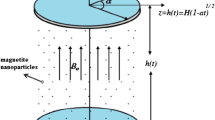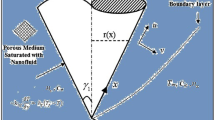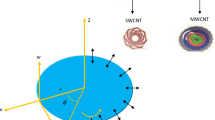Abstract
The remarkable features of carbon nanotubes (CNTs) such as physicochemical compatibility, high conductivity, effective electrical conductivity, light weight and stability (chemical, mechanical) form them a superlative substance to be manipulated in electrochemical mechanisms. Having such effectiveness of CNTs in view our intention in this investigation is to elaborate the significance of non-Darcian relation in flow of CNTs based on water by rotating disk. Outcomes for both CNTs (single walled, multi walled) are presented and elaborated. Thermal radiation and Partial slip aspects are further a part of this research. The process of non-dimensionalization is performed utilizing Von Kármán approach. Optimal homotopic scheme is employed for analysis. Velocity, Nusselt numbers, temperature and skin friction have been computed and addressed.




















Similar content being viewed by others
References
Bhatti MM, Zeeshan A, Ellahi R (2017) Simultaneous effects of coagulation and variable magnetic field on peristaltically induced motion of Jeffrey nanofluid containing gyrotactic microorganism. Microvasc Res 110:32–42
Choi SUS, Eastman JA (1995) Enhancing thermal conductivity of fluids with nanoparticles. In: The proceedings of the 1995 ASME international mechanical engineering congress and exposition, San Francisco, vol 66. ASME, FED 231/MD, pp 99–105
Darcy H (1856) Les Fontaines Publiques De La Ville De Dijon. Victor Dalmont, Paris
Das SK, Choi SUS, Patel HE (2006) Heat transfer in nanofluids—a review. Heat Transf Eng 27:3–19
Ding Y, Alias H, Wen D, Williams RA (2006) Heat transfer of aqueous suspensions of carbon nanotubes (CNT nanofluids). Int J Heat Mass Transf 49:240–250
Eastman JA, Phillpot SR, Choi SUS, Keblinski P (2004) Thermal transport in nanofluids. Annu Rev Mater Res 34:219–246
Forchheimer P (1901) Wasserbewegung durch boden. Zeitschrift des Vereins deutscher Ingenieure 45:1782–1788
Gireesha BJ, Mahanthesh B, Manjunatha PT, Gorla RSR (2015) Numerical solution for hydromagnetic boundary layer flow and heat transfer past a stretching surface embedded in non-Darcy porous medium with fluid-particle suspension. J Niger Math Soc 34:267–285
Harris PJF (2009) Carbon nanotube science: synthesis, properties and applications. Cambridge University Press, Cambridge
Hayat T, Ali S, Farooq MA, Alsaedi A (2015a) On comparison of series and numerical solutions for flow of Eyring–Powell fluid with Newtonian heating and internal heat generation/absorption. Plos One 10:e0129613
Hayat T, Rashid M, Imtiaz M, Alsaedi A (2015b) Magnetohydrodynamic (MHD) flow of Cu-water nanofluid due to a rotating disk with partial slip. AIP Adv 5:067169
Hayat T, Ali S, Alsaedi A, Alsulami HH (2016) Influence of thermal radiation and Joule heating in the Eyring–Powell fluid flow with the Soret and Dufour effects. J Appl Mech Tech Phys 57:1051–1060
Hayat T, Khan MI, Waqas M, Alsaedi A, Farooq M (2017a) Numerical simulation for melting heat transfer and radiation effects in stagnation point flow of carbon-water nanofluid. Comput Methods Appl Mech Eng 315:1011–1102
Hayat T, Waqas M, Alsaedi A, Bashir G, Alzahrani F (2017b) Magnetohydrodynamic (MHD) stretched flow of tangent hyperbolic nanoliquid with variable thickness. J Mol Liq 229:178–184
Hayat T, Haider F, Muhammad T, Alsaedi A (2017c) On Darcy–Forchheimer flow of carbon nanotubes due to a rotating disk. Int J Heat Mass Transf 112:248–254
Hayat T, Shah F, Alsaedi A, Waqas M (2018a) Numerical simulation for magneto nanofluid flow through a porous space with melting heat transfer. Microgravity Sci Tech 30:265–275
Hayat T, Aziz A, Muhammad T, Alsaedi A (2018b) An optimal analysis for Darcy–Forchheimer 3D flow of Carreau nanofluid with convectively heated surface. Results Phys 9:598–608
Iijima S (1991) Helical microtubules of graphitic carbon. Nature 354:56–58
Liao SJ (2010) An optimal homotopy-analysis approach for strongly nonlinear differential equations. Commun Nonlinear Sci Numer Simul 15:2003–2016
Mahbubul IM, Saidur R, Amalina MA, Niza ME (2016) Influence of ultrasonication duration on rheological properties of nanofluid: an experimental study with alumina–water nanofluid. Int Commun Heat Mass Transf 76:33–40
Mamourian M, Shirvan KM, Ellahi R, Rahimi AB (2016) Optimization of mixed convection heat transfer with entropy generation in a wavy surface square lid-driven cavity by means of Taguchi approach. Int J Heat Mass Transf 102:544–554
Mohanty S, Patra PK, Sahoo SS, Mohanty A (2017) Forecasting of solar energy with application for a growing economy like India: survey and implication. Renew Sustain Energy Rev 78:539–553
Muskat M, Meres MW (1936) The flow of heterogeneous fluids through porous media. J Appl Phys 7:346
Sadiq MA, Waqas M, Hayat T (2017) Importance of Darcy–Forchheimer relation in chemically reactive radiating flow towards convectively heated surface. J Mol Liq 248:1071–1077
Shehzad N, Zeeshan A, Ellahi R, Vafai K (2016) Convective heat transfer of nanofluid in a wavy channel: Buongiorno’s mathematical model. J Mol Liq 222:446–455
Thostenson ET, Ren Z, Chou TW (2001) Advances in the science and technology of carbon nanotubes and their composites: a review. Compos Sci Technol 61:1899–1912
Veyskarami M, Hassani AH, Ghazanfari MH (2016) Modeling of non-Darcy flow through anisotropic porous media: role of pore space profiles. Chem Eng Sci 151:93–104
Waqas M, Farooq M, Khan MI, Alsaedi A, Hayat T, Yasmeen T (2016) Magnetohydrodynamic (MHD) mixed convection flow of micropolar liquid due to nonlinear stretched sheet with convective condition. Int J Heat Mass Transf 102:766–772
Waqas M, Hayat T, Shehzad SA, Alsaedi A (2018) Transport of magnetohydrodynamic nanomaterial in a stratified medium considering gyrotactic microorganisms. Phys B 529:33–40
Wilder JW, Venema LC, Rinzler AG, Smalley RE, Dekker C (1998) Electronic structure of atomically resolved carbon nanotubes. Nature 391:59–62
Xue Q (2005) Model for thermal conductivity of carbon nanotube-based composites. Phys B Condens Matter 368:302–307
Yu W, France DM, Choi SU, Routbort JL (2007) Review and assessment of nanofluid technology for transportation and other applications. Argonne National Laboratory (ANL)
Author information
Authors and Affiliations
Corresponding author
Ethics declarations
Conflict of interest
There are no conflicts to declare.
Additional information
Publisher’s Note
Springer Nature remains neutral with regard to jurisdictional claims in published maps and institutional affiliations.
Rights and permissions
About this article
Cite this article
Waqas, M., Hayat, T. & Alsaedi, A. A theoretical analysis of SWCNT–MWCNT and H2O nanofluids considering Darcy–Forchheimer relation. Appl Nanosci 9, 1183–1191 (2019). https://doi.org/10.1007/s13204-018-0833-6
Received:
Accepted:
Published:
Issue Date:
DOI: https://doi.org/10.1007/s13204-018-0833-6




